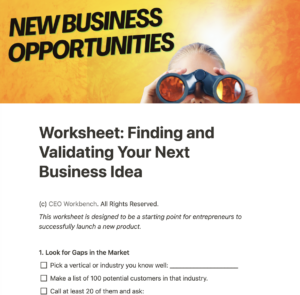The siren song of entrepreneurship is the chance to build something truly novel – to see a void in the marketplace and fill it with innovation that unlocks value for customers (and profit for you). But how do you know if that gap you’ve spotted is just a mirage, or a genuine blue ocean of opportunity? Here’s how to hunt for and validate venture ideas poised for liftoff.
Look for Gaps
The best way to find opportunity is to look for what the market needs, not what you think it needs. If you build it, they might not come. But if they want it already – there’s the opportunity.
I talked with a serial entrepreneur who had the same strategy every time he founded a company. He’d pick a vertical he knew a little about, and call 100 people who would be a target customer. He’d ask each one the same questions: (a) what frustrates you on a weekly basis? (b) what can’t you track or understand well? (c) where aren’t your current vendors providing value?
These questions get right to the heart of where the gaps are. This works for both B2B and consumer problems.
My suggestion: actually call people. Surveys can work – but having a discussion lets you dig in deeper and discover things that a survey might never catch.
Yeah. It’s work. But so is founding a company and running it for two years only to find that you’re not solving a problem anyone really cares about.
Brainstorming Is Less Productive
Brainstorming is great. We love brainstorming. Unfortunately, often it’s satisfying your urge to be creative rather than find a real market need.
If you’re going to brainstorm, constrain it to where you already have expertise. Why? Because you are uniquely suited to looking for problems and finding solutions in those areas.
Brainstorming about areas where you have no expertise is going to lead you down rabbit holes – because you don’t know what’s been tried already, what’s worked already, and who the players in the market are. While there are some companies who start with a blank page and hit it big – that’s a one in a million shot. Most of the time those fail.
Get Punched In The Face Early
“Everybody has a plan until they get punched in the mouth” said Mike Tyson. It’s true in starting a business too. In the idea stage we’re excited. We think we’ve got it. The next big thing.
Most ideas don’t survive contact with the market. So get that out of the way fast. Nothing validates like data from real customers, even early on. Set up landing pages describing the concept and start collecting potential user interest even before you build anything. Build scrappy prototypes and minimum viable products. Your goal is to refine and de-risk ideas with market feedback BEFORE you jump fully in.
Not getting the response you expected? Find out WHY. Pay attention and adjust – or kill the project. The hardest but most important thing is killing ideas that aren’t resonating with the market.
Your energy and time are the most precious commodities. Don’t fall in love with an idea the market doesn’t want. You’ll have others. It’s better to fail fast when failure is cheap.
The Overnight Success Myth
Once you’ve gotten initial validation in the market (remember: not you thinking it’s a good idea, the market thinking it is) – it’s time to iterate towards success. I find it helpful to set benchmarks every 90 days for the first year of “I know this idea is getting traction if…” and review those quarterly. It helps keep me honest.
The first version of most products suck – and they should. In the words of Reid Hoffman, “if you’re not embarrassed by the first version of your product, you’ve launched too late.” That’s not only because competition is on your heels, but because trying to make it perfect is all guesswork until it meets the market.
The Recipe: Get Comfortable with Uncertainty
While new ideas can have massive potential, executing means living with uncertainty. The surprising thing I find is that the best entrepreneurs are actually risk averse. They don’t take fliers – they’re scientists. Have a hypothesis, test, revise hypothesis, repeat.
It’s a paradox – but when spinning up a new venture go slow to go fast.
Want a detailed, step-by-step worksheet on how to do this? It’s available for free at CEOWorkbench.com


